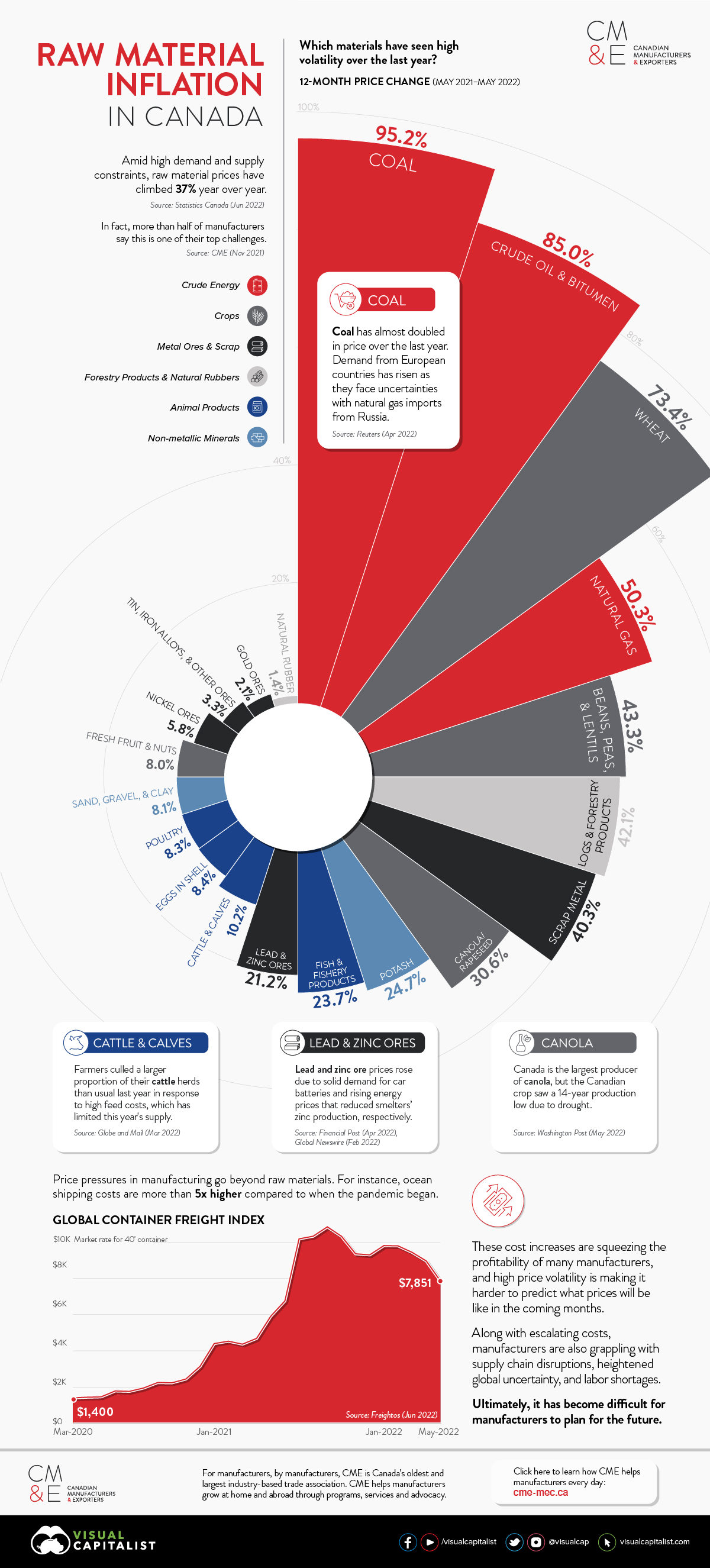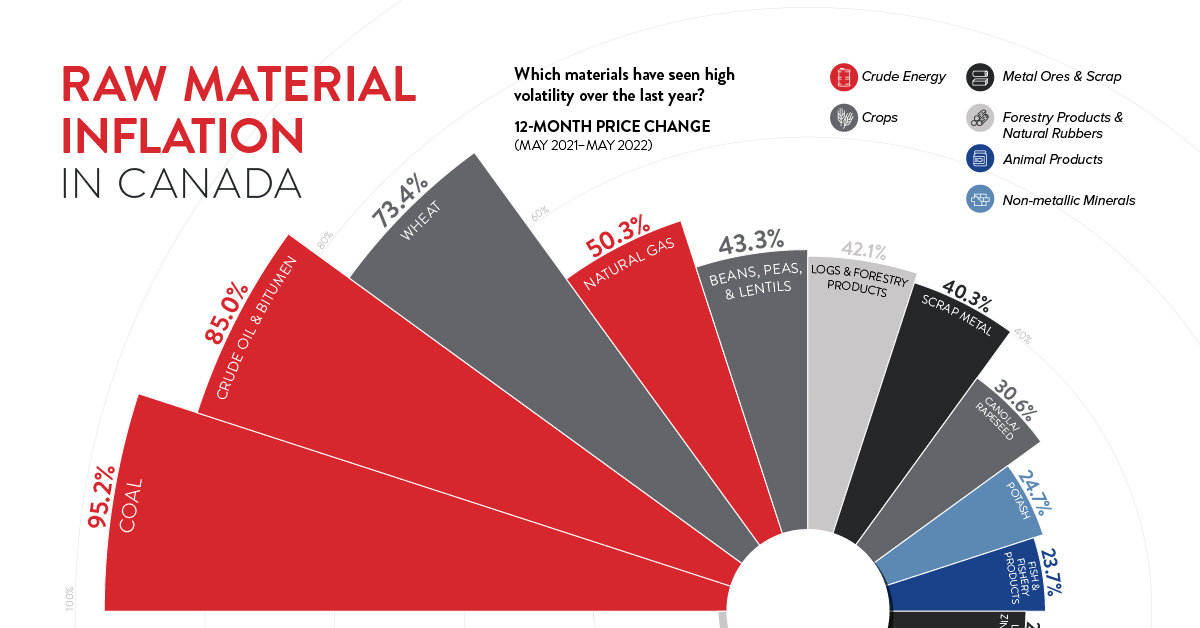Visualizing Raw Material Inflation in Canada
The following content is sponsored by Canadian Manufacturers & Exporters.

Raw Material Inflation in Canada
Inflation in Canada is climbing, and it has impacted the raw materials manufacturers use to produce goods. In fact, raw material prices have climbed 37% year-over-year on average.
More than half of manufacturers say this is one of their top challenges. In this graphic from Canadian Manufacturers & Exporters (CME), we show which materials have seen the biggest price spikes over the last year.
Inflation by Raw Material
The table below shows the rate of inflation in Canada for select raw materials from May 2021 to May 2022.
| Raw Material | Category | Price Change (May 2021-May 2022) |
|---|---|---|
| Coal | Crude Energy | 95.2% |
| Crude Oil & Bitumen | Crude Energy | 85.0% |
| Wheat | Crops | 73.4% |
| Natural Gas | Crude Energy | 50.3% |
| Beans, Peas, & Lentils | Crops | 43.3% |
| Logs & Forestry Products | Forestry Products & Natural Rubber | 42.1% |
| Scrap Metal | Metal Ores & Scrap | 40.3% |
| Canola/Rapeseed | Crops | 30.6% |
| Potash | Non-metallic Minerals | 24.7% |
| Fish & Fishery Products | Animal Products | 23.7% |
| Lead & Zinc Ores | Metal Ores & Scrap | 21.2% |
| Cattle & Calves | Animal Products | 10.2% |
| Eggs in Shell | Animal Products | 8.4% |
| Poultry | Animal Products | 8.3% |
| Sand, Gravel, & Clay | Non-metallic Minerals | 8.1% |
| Fresh Fruit & Nuts | Crops | 8.0% |
| Nickel Ores | Metal Ores & Scrap | 5.8% |
| Tin, Iron Alloys, & Other Ores | Metal Ores & Scrap | 3.3% |
| Gold Ores | Metal Ores & Scrap | 2.1% |
| Natural Rubber | Forestry Products & Natural Rubber | 1.4% |
Crude energy materials led the rise, with the price of coal nearly doubling over the last year. Oil and natural gas prices also rose amid war-related supply constraints and higher demand as people got back to pre-pandemic activities. This has far-reaching consequences for manufacturers given that oil and gas is widely used for transportation and heat, and is an input in thousands of products.
Wheat inflation in Canada reached 73.4%. The cost increase was partly due to a drought in Western Canada that reduced Canadian wheat production by nearly 40% from 2020 to 2021. Internationally, the Russia-Ukraine conflict also threatened wheat supply as the two countries normally account for almost a third of global wheat exports. Wheat inflation has affected food and fuel manufacturers the most, as it is used for livestock feed, biofuels, and a wide range of human food.
Simultaneously, the price of lumber increased by 42.1% because of an increased demand for housing, and flooding in British Columbia that reduced supply. This affects manufacturers who produce things like timber and plywood, and ultimately influences the cost of housing.
How Inflation in Canada Affects Manufacturers
Raw material inflation drives up manufacturers’ cost of doing business. Unfortunately, it isn’t the only price pressure they face. Ocean shipping costs are more than five times higher compared to when the pandemic began. Truck transportation costs rose by 15% from March 2021 to March 2022, based on the latest available data.
On top of this, manufacturers have to contend with supply chain disruptions, global uncertainty, and labor shortages. What can manufacturers do? A majority of manufacturers have been raising prices to pass on some of the additional costs to consumers.
| Response to Supply Chain Challenges | % of Manufacturers |
|---|---|
| Increase prices | 80% |
| Delay fulfilling customer orders | 79% |
| Find alternative supplier of raw materials and other inputs | 69% |
| Increase inventories | 63% |
| Cut production | 30% |
| Lay off workers | 9% |
| Other | 7% |
Over the longer term, manufacturers say they plan to build stronger relationships with customers and suppliers, source critical raw materials from two suppliers, and bring their supplier base and production closer to home.
Looking ahead, most manufacturers say they expect supply chain issues to be resolved some time in 2023—though they were last asked this question before the war in Ukraine began. The Bank of Canada also expects inflation in Canada to ease in the second half of 2023. In the meantime, manufacturers will be forced to adapt to rising costs.
Learn more about how CME helps manufacturers grow at home and abroad through programs, services, and advocacy.
-

 Sponsored3 years ago
Sponsored3 years agoMore Than Precious: Silver’s Role in the New Energy Era (Part 3 of 3)
Long known as a precious metal, silver in solar and EV technologies will redefine its role and importance to a greener economy.
-

 Sponsored7 years ago
Sponsored7 years agoThe History and Evolution of the Video Games Market
Everything from Pong to the rise of mobile gaming and AR/VR. Learn about the $100 billion video games market in this giant infographic.
-

 Sponsored8 years ago
Sponsored8 years agoThe Extraordinary Raw Materials in an iPhone 6s
Over 700 million iPhones have now been sold, but the iPhone would not exist if it were not for the raw materials that make the technology...
-

 Sponsored8 years ago
Sponsored8 years agoThe Industrial Internet, and How It’s Revolutionizing Mining
The convergence of the global industrial sector with big data and the internet of things, or the Industrial Internet, will revolutionize how mining works.


